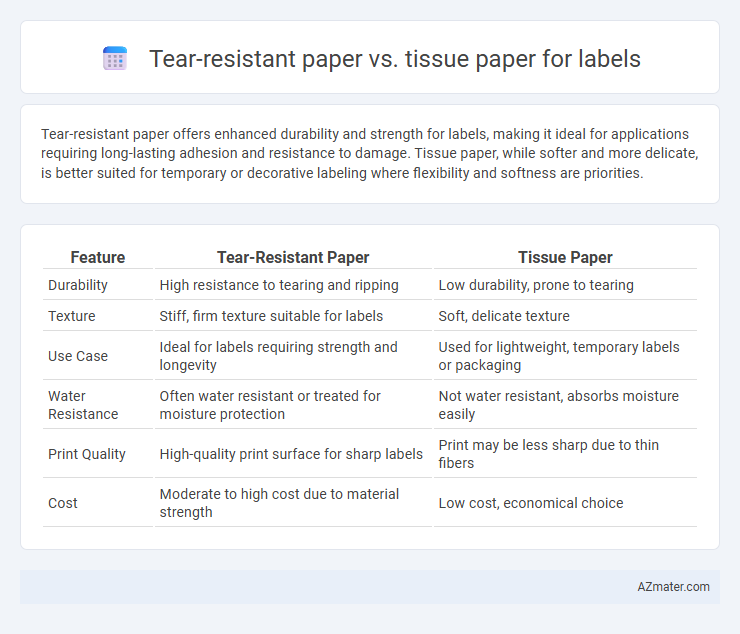Tear-resistant paper offers enhanced durability and strength for labels, making it ideal for applications requiring long-lasting adhesion and resistance to damage. Tissue paper, while softer and more delicate, is better suited for temporary or decorative labeling where flexibility and softness are priorities.
Table of Comparison
| Feature | Tear-Resistant Paper | Tissue Paper |
|---|---|---|
| Durability | High resistance to tearing and ripping | Low durability, prone to tearing |
| Texture | Stiff, firm texture suitable for labels | Soft, delicate texture |
| Use Case | Ideal for labels requiring strength and longevity | Used for lightweight, temporary labels or packaging |
| Water Resistance | Often water resistant or treated for moisture protection | Not water resistant, absorbs moisture easily |
| Print Quality | High-quality print surface for sharp labels | Print may be less sharp due to thin fibers |
| Cost | Moderate to high cost due to material strength | Low cost, economical choice |
Introduction to Label Materials
Tear-resistant paper offers enhanced durability and longevity for labels, making it ideal for applications requiring resistance to ripping and harsh handling. Tissue paper, while thinner and more delicate, provides a lightweight and flexible option commonly used for temporary labels and packaging accents. Choosing between these materials depends on the label's functional requirements and environmental exposure.
Overview of Tear-Resistant Paper
Tear-resistant paper offers superior durability and strength compared to standard tissue paper, making it ideal for labels exposed to rough handling or outdoor conditions. Engineered with reinforced fibers and specialized coatings, tear-resistant paper maintains the integrity of printed information without easily ripping or tearing. This ensures long-lasting label adhesion and readability in demanding environments such as industrial settings, shipping, and product packaging.
Characteristics of Tissue Paper for Labels
Tissue paper for labels is lightweight, thin, and highly porous, providing excellent breathability and easy tearability, which makes it ideal for short-term applications where delicate functionality is required. Its smooth surface ensures good ink absorption and print clarity, although it lacks the durability and water resistance found in tear-resistant paper. Commonly used in cosmetics and delicate product packaging, tissue paper labels offer an elegant, soft-touch aesthetic but have limited resistance to abrasion and moisture.
Durability: Tear-Resistant vs Tissue Paper
Tear-resistant paper offers superior durability for labels, resisting rips and abrasions even under harsh handling or environmental conditions, making it ideal for long-lasting applications. Tissue paper, by contrast, is thin and fragile, prone to tearing easily, which limits its use to short-term or decorative labels where durability is not a priority. Choosing tear-resistant paper ensures labels maintain integrity and readability throughout the product lifecycle.
Print Quality and Ink Absorption
Tear-resistant paper for labels offers superior print quality due to its smooth surface, ensuring sharp and vibrant ink adhesion, while tissue paper's porous texture often results in ink bleed and less precise imaging. Ink absorption in tear-resistant paper is controlled, enabling quicker drying times and enhanced durability of printed designs. Tissue paper absorbs ink more readily but sacrifices clarity and detail, making it less suitable for high-resolution label printing.
Water and Chemical Resistance Comparison
Tear-resistant paper offers superior water and chemical resistance compared to tissue paper, making it ideal for labels exposed to harsh environments and moisture. While tissue paper is prone to deformation and ink smudging when wet, tear-resistant paper maintains its integrity and readability due to its enhanced fiber strength and protective coatings. This durability ensures that labels remain legible and intact on products subjected to water or chemical exposure, improving overall label performance and longevity.
Application Suitability for Different Industries
Tear-resistant paper labels excel in industrial environments requiring high durability, chemical resistance, and abrasion protection, making them ideal for manufacturing, automotive, and electronics industries where labels undergo rough handling. Tissue paper labels, characterized by their softness and biodegradability, are preferred in food packaging, cosmetics, and healthcare sectors where gentle application and environmental sustainability are priorities. Selecting between tear-resistant and tissue paper labels depends on industry-specific demands for durability, flexibility, and eco-friendliness.
Environmental Impact and Sustainability
Tear-resistant paper used for labels offers superior durability, reducing the need for frequent replacements and minimizing waste, which contributes positively to environmental sustainability. Tissue paper, being more biodegradable and often made from recycled fibers, provides an eco-friendly option but lacks the longevity required for many labeling applications, potentially leading to higher consumption and waste. Choosing tear-resistant paper with recycled content and eco-friendly inks can balance durability with sustainability, making it a preferable choice for environmentally conscious labeling solutions.
Cost Considerations
Tear-resistant paper for labels typically incurs higher manufacturing costs due to its enhanced durability and specialized materials like reinforced fibers or synthetic blends, making it a premium choice for long-term applications. Tissue paper labels, while significantly cheaper and widely available, offer limited durability and are prone to tearing and moisture damage, which can increase replacement frequency and overall expenses. Businesses aiming for cost efficiency must balance the upfront higher cost of tear-resistant paper against potential savings from reduced label replacements and improved product presentation.
Choosing the Right Paper for Your Labels
Tear-resistant paper offers superior durability and longevity, making it ideal for labels exposed to harsh conditions or frequent handling. Tissue paper provides a softer, more delicate texture suitable for lightweight, decorative labels but lacks the strength needed for long-term use. Selecting the right paper depends on label application, with tear-resistant options recommended for industrial or outdoor environments and tissue paper best suited for aesthetic purposes or temporary labeling.

Infographic: Tear-resistant paper vs Tissue paper for Label
 azmater.com
azmater.com